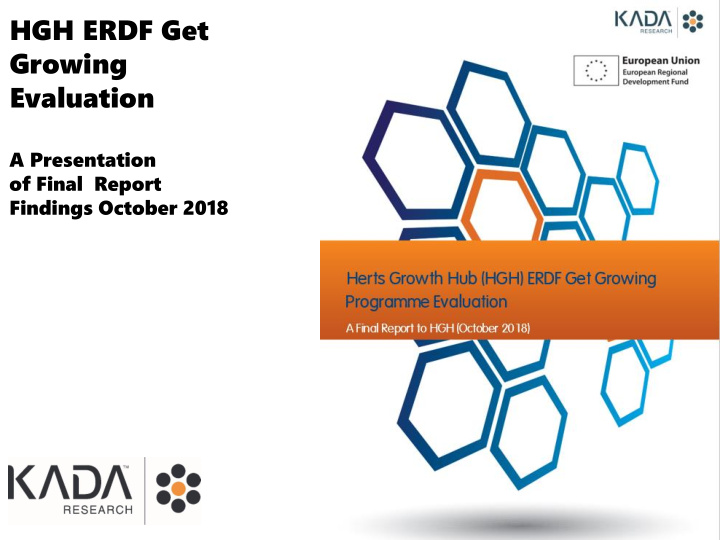



HGH ERDF Get Growing Evaluation A Presentation of Final Report Findings October 2018
An independent assessment of: Progress towards project objectives. The validity of original rationale & strategic fit. Quantitative impact of performance. Value for money /cost effectiveness. Management, delivery and operation. With recommendations to improve future delivery, beneficiaries experience and outcomes.
Wider benefits May achieve at a future date Not achieved and unlikely to Will achieve at a future date Achieved already Not sure Improved marketing or branding 35 37% 30 32% 13 14% 11 12% 6 6% Improved leadership culture 32 34% 24 25% 13 14% 20 21% 6 6% Better understanding of profit 30 32% 13 14% 14 15% 26 27% 12 13% Better use of digital technology within the business 29 31% 20 21% 16 17% 24 25% 6 6% Acceleration in innovation strategy and activities 27 28% 15 16% 20 21% 25 26% 8 8% Improved productivity 27 28% 27 28% 16 17% 15 16% 10 11% Better customer relations 26 27% 24 25% 11 12% 25 26% 9 9% Better talent pipeline 22 23% 19 20% 25 26% 20 21% 9 9% Source: Kada Research, 2018 n=95
Good use of engagement channels. A mixed approach to marketing. Increased propensity for growth. Improvements in approaches to growth. Firms overcoming key barriers. Significant time & scale additionality. Substantial anticipated jobs. Improvements in products to market. High advisor ratings eg professionalism. Appetite for marketing, funding & export support.
The rationale and market failures remain valid. Delivery model - worked well/fit for purpose. Stakeholders praised mixing diagnosis with in- depth interaction and workshops and events. Networking and speaker events professionally organised, well attended: meeting market needs. The diagnostic: an effective filter and signposted businesses to the right support. Good links with partners developed. A slow start due to delay in funding agreement but got back on track to deliver all outcomes. Greater use of technology and more efficient paperwork and administration could be considered.
Reached some immature SMEs initially but during the second half of the programme a heavy focus on missing middle. Linked well with local business support and evidence of extensive cross-referral. Delivery/admin was thorough and organised. Added value: businesses were informed about a range of support on offer. Events met market needs - an enthusiastic response from business and good attendance. The Programme should continue at least on the same scale or be expanded, building on momentum gained keeping continuity of the brand. Changes in policy provide an opportunity to reflect on some refinements to the current model.
Partial success towards Objective 1 with evidence of more recent success (seek out, target, identify and engage non-micro SMEs with the potential to create wealth & jobs). O2 (provide SMEs with an integrated programme of business support through a team of specialist advisers, backed by individual SME Growth Plans, to refocus them onto growth and realise potential as creators of wealth, innovation and jobs). Model and survey evidence suggest success. O3: (to complement, streamline, promote and add value to the services of the HGH, and the County’s wider business support ecosystem). Consensus this has been achieved. Two out of the three objectives achieved with the third (O1) partially achieved.
I. Better focus on the ‘missing middle’ from the outset. II. Business engagement measures to boost county-wide representation. III. Enhanced web presence. IV. Dissemination of evaluation findings. V. Process and administrative refinements & better use of technology. VI. Systematic management of the referral process. I. Securing additional EU funds? II. Consider expansion of the one to many element and intensive work with scale-ups. III. Positioning to meet the requirements of the UK Prosperity Fund.
Recommend
More recommend